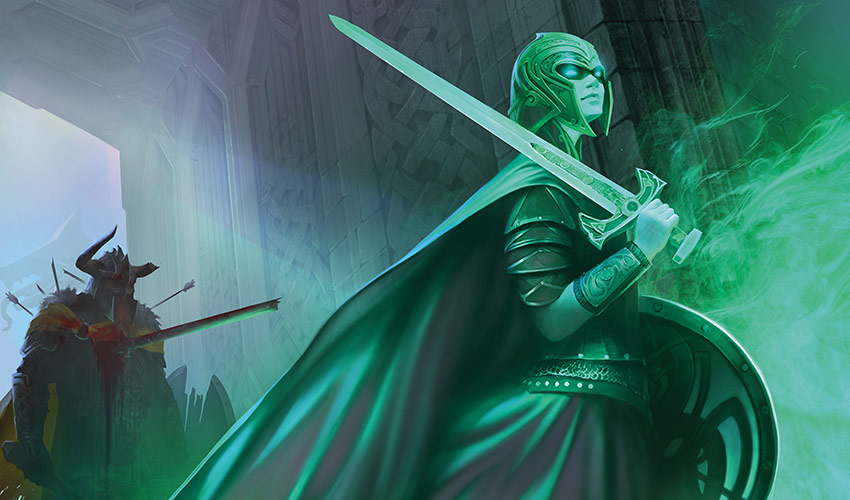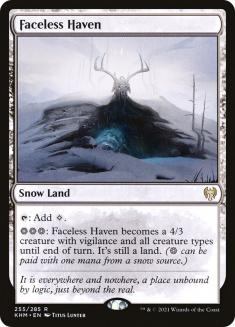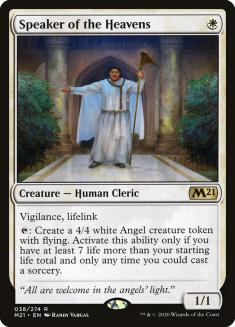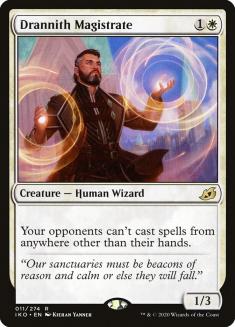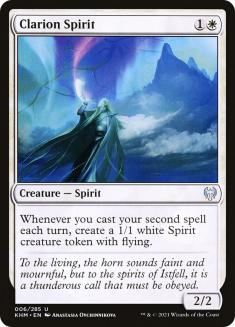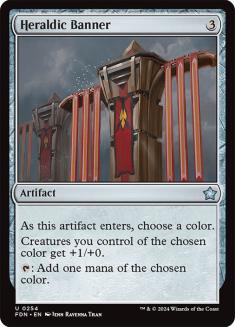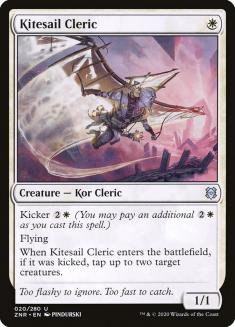Kaldheim Standard season has officially kicked off and the Standard metagame is already churning. Izzet Midrange❄, the darling of last weekend, already has its doubters and may already be outdated. Sultai decks took first and second place in last weekend’s Kaldheim Championship Qualifier, and Rakdos decks of various stripes are performing well now that they have a Pathway of their very own.
Combine these developments with the hype around Showdown of the Skalds and there’s a lot to unpack, but one of my biggest takeaways from the weekend was the emergence of Mono-White Aggro. A fringe deck last season, Mono-White has picked up some new tools and now has a sizable card pool to draw from. So large, in fact, that there is no consensus build.
Normally, monocolored aggro decks are so limited in what cards they can play that they’re scraping the bottom of the barrel to fill out the last few slots, so when you have enough depth to build multiple different variants, that’s a great sign. It means that you aren’t sacrificing much in the way of power level in order to gain the consistency that sticking to a single color provides.
I’m also impressed by the amount of interaction that these decks have. White normally isn’t known for its ability to interact with creatures outside of sweepers, but between Skyclave Apparition, Kabira Takedown, and Giant Killer you have plenty of interaction points, and you don’t have to sacrifice threat density to play them in large quantities. If your aggro deck has to maindeck cards like Glass Casket to get through Lovestruck Beast, you aren’t in a good place.
Let’s take a look at a few different lists of Mono-White Aggro that have had success in the early days of this Standard season, examining their strengths and weaknesses, and then I’ll show you the list that I would start with moving forward.
The Base List
Creatures (32)
- 2 Shepherd of the Flock
- 4 Seasoned Hallowblade
- 4 Selfless Savior
- 4 Speaker of the Heavens
- 4 Skyclave Apparition
- 4 Luminarch Aspirant
- 4 Halvar, God of Battle
- 4 Usher of the Fallen
- 2 Reidane, God of the Worthy
Lands (22)
Spells (6)

This is the most straightforward way to build the deck. There’s no fluff, and you’re maxed out on all the core cards. I particularly like Halvar, God of Battle as a curve-topper. It lets you apply a ton of pressure with any creature plus Maul of the Skyclaves for matchups that are about speed, while Sword of the Realms offers some card advantage in games that come down to attrition. For an archetype that typically doesn’t want to see sweepers in the opposing list, having Sword of the Realms as well as Maul of the Skyclaves as threats that you can use to keep applying pressure on your opponent without overextending is quite the luxury.
That said, sweepers are still a concern, and that’s why you see two copies of Reidane, God of the Worthy. It’ll at least delay that Extinction Event or Doomskar long enough for you to close the game, and in creature matchups it’s a nice evasive threat that you can stack counters onto with Luminarch Aspirant. Disrupting snow lands is an ancillary benefit, but in the matchups where it’s relevant, Reidane will be among your most important cards.
This all adds up to a card with a relatively high floor since it’s relevant in different types of matchups, but a very high ceiling. I would like to see more copies but as a legendary creature it has high diminishing returns, and the reverse side is not something I’m interested in, unlike with Halvar.
Lastly, the most important addition to the deck, in my opinion, is Faceless Haven. Creature-lands are so powerful for aggro decks since they’re great for punching through the last points of damage or preventing your opponents from safely landing planeswalkers. They’re also great flood protection, which is important because when you commit to being aggressive, you commit to having underpowered cards compared to your opponents, so you often don’t have the ability to lean on Yorion, Sky Nomad or Genesis Ultimatum to take over a game by itself when you’ve drawn a few too many lands.
And as far as creature-lands go, Faceless Haven is quite strong. On rate it compares favorably to recent printings Crawling Barrens and Mobilized District so long as you load up on snow lands, which monocolored decks are prepared to do without issue. Without a double-colored two-drop, I would default to the full four copies and pare down as needed rather than risk being too conservative on such a powerful effect for the deck.
As far as cards I haven’t liked, I’m looking at Speaker of the Heavens. Without playing a bunch of weak cards to enable it, you’re left with a weak body that only makes Angel tokens when you pump it with Luminarch Aspirant and Equipment. And if your opponent fails to answer a creature you’ve invested extra resources into, they’re likely going to lose regardless. Selfless Savior helps out here, but I’d rather get Giant Killer into the maindeck and have another piece of interaction. The floor on Speaker is just too low.
I’m also not high on Shepherd of the Flock in a deck that lacks Adventure synergies or a high-value permanent to bounce like Showdown of the Skalds. It’ll have its moments protecting a key threat from removal, but like Speaker, its floor as a Blade of the Sixth Pride is very low. Aggro decks rely on consistency, so I avoid cards that come with the risk of making you look like you’re playing a Draft deck.
Protect the Queen
Creatures (31)
- 3 Giant Killer
- 3 Alseid of Life's Bounty
- 2 Drannith Magistrate
- 3 Lurrus of the Dream-Den
- 2 Seasoned Hallowblade
- 3 Selfless Savior
- 4 Speaker of the Heavens
- 4 Skyclave Apparition
- 4 Luminarch Aspirant
- 3 Reidane, God of the Worthy
Planeswalkers (1)
Lands (22)
Spells (6)

The second list slows things down a bit in order to include more disruptive elements as well as Lurrus of the Dream-Den in order to recur key threats. As a result, you see Alseid of Life’s Bounty and Fight as One in addition to Selfless Savior since they can protect those key threats. The cost is Usher of the Fallen, which on pure stats is one of the best white one-drops printed in recent years.
You might be tempted to replace the Speaker of the Heavens with Ushers given my previous remarks, but I think this is a much better home for Speaker than a more aggressive list, since you can more readily protect it and are looking to play a longer game where the upside of Speaker is going to come up more often. There’s a lot of overlap with the first list, but this one is going to play out much differently, and that changes how you evaluate each card choice.
Keeping with the disruption theme, there are additional copies of Reidane to keep your opponent off-balance, and two copies of Drannith Magistrate. Magistrate helps against Adventure creatures, Showdown of the Skalds, and one of the breakout cards of last weekend in Emergent Ultimatum. So it’s an intriguing idea, especially given the pedigree of disruptive white aggro decks in other formats.
My issue with decks like these is that they often struggle with opposing creature strategies, since your disruptive creatures are weaker in combat. You only have so much removal to answer the various Lovestruck Beasts and Bonecrusher Giants that look to dominate the battlefield.
You also lack the kind of card selection needed to find your disruptive elements reliably. In older formats where you have things like Ghost Quarter and Wasteland, you can fit more disruption into the deck without sacrificing threat density, but that’s not the case here. This list has to cut the power of Halvar at the top of the curve and trim on Maul of the Skyclaves to make everything fit.
You’re effectively giving away some of your early-game advantage by enacting a slower gameplan, at which point I’d question why you’re not simply adding red to play powerful cards like Bonecrusher Giant and Showdown of the Skalds. It can be attractive to play the hate card and imagine shutting everyone else down, but in my experience, it’s better to just play the powerful cards yourself unless you’re going to commit to being an aggro deck and get underneath those cards.
Going Wide
Creatures (29)
- 4 Faerie Guidemother
- 4 Giant Killer
- 1 Legion Angel
- 4 Kitesail Cleric
- 4 Luminarch Aspirant
- 4 Codespell Cleric
- 4 Clarion Spirit
- 4 Battlefield Raptor
Lands (20)
Spells (11)

This list comes from the mind of aggro master Aaron Barich, and unsurprisingly is the most unusual of the three. It’s built around the synergy between Clarion Spirit and Heraldic Banner, letting you power out a huge battlefield of cheap creatures and pump them all to attack for a ton of damage. So while a lot of the cards here look strange in isolation, they make perfect sense when you understand how focused the list is.
You would never play a card like Kitesail Cleric over Usher of the Fallen in normal circumstances, but this list doesn’t have space for a lot of removal since it needs plenty of creatures and pump effects to enact its gameplan consistently. As such, there’s a premium on flying creatures so you don’t have to worry about opposing blockers; you can just race.
Similarly Seasoned Hallowblade is going to underperform in any matchup where your opponent can block on the ground, but still makes a great sideboard card against control decks, so you see the full four copies there.
Personally, I love lists like this, where the deck is more than the sum of its parts. I liken it to Mono-Blue Devotion in the Theros era, where the power of Thassa, God of the Sea and Master of Waves made it okay to register Cloudfin Raptor and Tidebinder Mage. When you’re taking a deck in this direction, you need your payoff cards to carry a lot of weight, and while I think Clarion Spirit is a powerful card, it’s a tough sell in a world of Bonecrusher Giants. I wouldn’t mind Selfless Savior here even though it’s not airborne simply because protecting Clarion Spirit and to a lesser extent Luminarch Aspirant is so important here.
Your other major payoffs for playing a bunch of cheap creatures are Glorious Anthem and Heraldic Banner, and unfortunately the current metagame is full of Disenchant effects since everyone needs to answer Embercleave, The Great Henge, Glass Casket, and the like. Embereth Shieldbreaker sees maindeck play, and cards like Wilt, Heliod’s Intervention, and Shredded Sails are commonplace in sideboards.
For Mono-Blue Devotion, Thassa was very difficult to interact with and Master of Waves both demanded an immediate answer and blanked red removal. I don’t see that same resilience in the payoffs for this list, so I’d only consider it in a metagame where efficient answers to the payoff cards are rare.
Where I’d Start
Given everything I’ve touched on, here’s my preferred list for Mono-White Aggro:
Creatures (30)
- 4 Giant Killer
- 4 Seasoned Hallowblade
- 4 Selfless Savior
- 4 Skyclave Apparition
- 4 Luminarch Aspirant
- 4 Halvar, God of Battle
- 4 Usher of the Fallen
- 2 Reidane, God of the Worthy
Lands (22)
Spells (8)

This list is straightforwardly aggressive like the first, but naturally has a better long game with the extra removal in the maindeck and the full four copies of Faceless Haven. This improved late-game comes at little to no sacrifice in the early-game, which is important since you’re mostly planning to win in the first five or six turns.
I also like using a couple of copies of Sentinel’s Eyes in the maindeck, which helps your creatures rumble against the likes of Lovestruck Beast while synergizing nicely with Halvar and surprising your Dimir Rogues opponents. It also plays nicely with Seasoned Hallowblade, offering an easy card to discard and later on letting your hard-to-kill creature play both offense and defense by granting it vigilance. It’s a low-cost card that can have a major impact on the game and it’ll never be dead, so I like it in small numbers.
Ultimately I think the white cards are strong enough that you don’t need to resort to any gimmicks, nor do you need to muck up the manabase by adding another color. The power of Showdown of the Skalds is tempting, but it leads to you playing your opponent’s game. I don’t want to take a turn off from developing my battlefield and give my opponent the time they need to establish their defenses. They are favored going long, so it’s imperative that you close the game out before they get to the late-game.
That’s why all of my sideboard cards that function to help you recover from sweepers help immediately rebuild your battlefield in the face of a sweeper. Lurrus of the Dream-Den and Elspeth, Sun’s Nemesis create two bodies and Glorious Protector stops the sweeper entirely. It’s all about maintaining pressure without needing to put all your cards on the table and pray your opponent doesn’t have the right answers.
As such, this list isn’t designed to be blindly aggressive, but to pace your threats so that your opponent is never entirely comfortable. You want them to be on the back foot, but with no clear way to get out of it because you always have something in reserve. Even if it takes you another turn or two to literally end the game, the ability to do so without exposing yourself to a sweeper or planeswalker is worth it.
White has taken a lot of flak recently for lagging behind the other colors, but with powerful recent printings like Skyclave Apparition and Luminarch Aspirant and now Usher of the Fallen and Halvar, God of Battle, it’s ready to compete with the best of them. It has a good curve, good interaction that doesn’t sacrifice threat density, plenty of ways to fight through removal, and places to sink its mana as the game drags on. That’s my checklist for aggro strategies.

